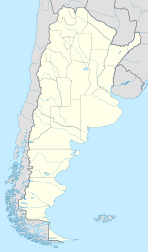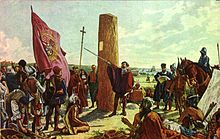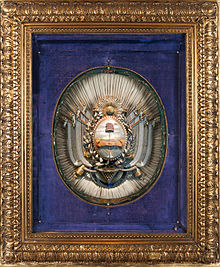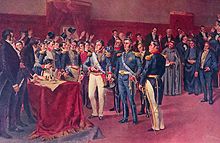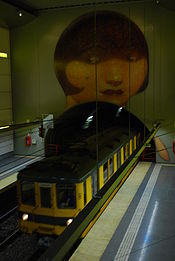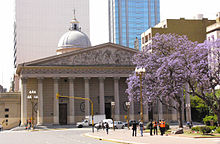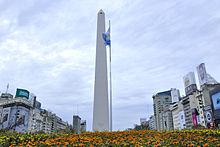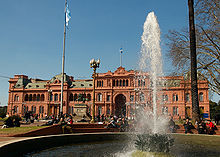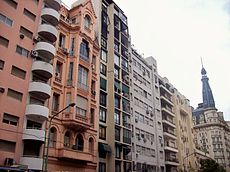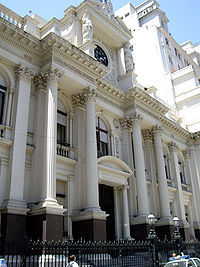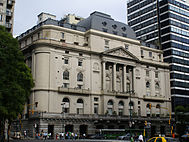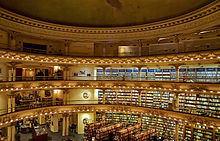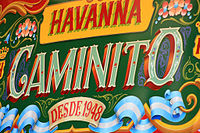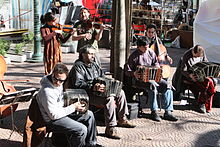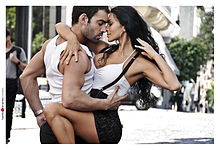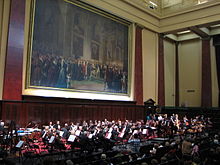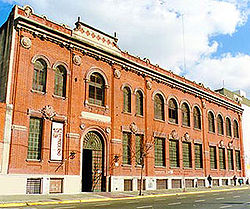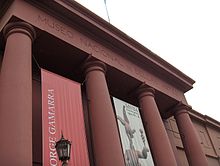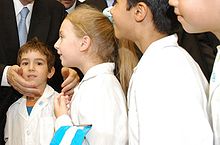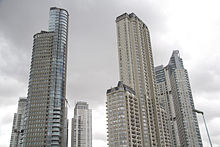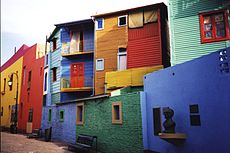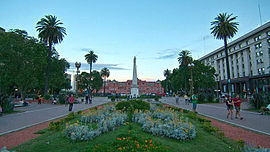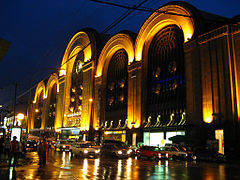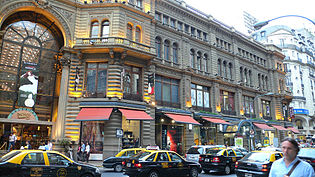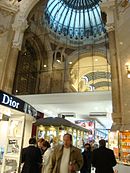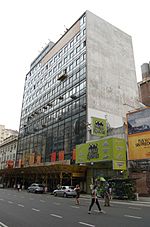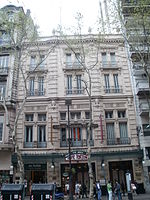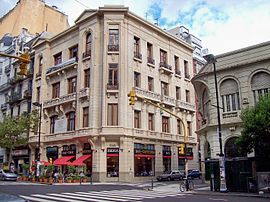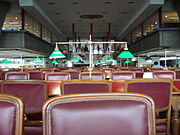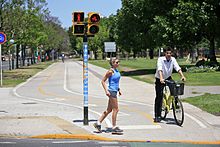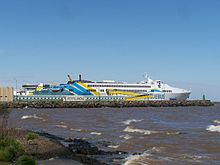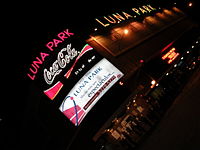
Buenos Aires
About this schools Wikipedia selection
SOS Children made this Wikipedia selection alongside other schools resources. SOS Children works in 45 African countries; can you help a child in Africa?
| Autonomous City of Buenos Aires | |||
|---|---|---|---|
| — Autonomous City — | |||
| Ciudad Autónoma de Buenos Aires | |||
| Clockwise from top: skyline of the city at dusk, the National Congress, the Woman's Bridge in Puerto Madero, Tango dancers in San Telmo, the Pink House, the Metropolitan Cathedral, Cabildo, the Obelisk, Colón Theatre, La Recoleta Cemetery, the Planetarium in the Palermo Woods, and Caminito in La Boca. | |||
|
|||
| Nickname(s): The Queen of El Plata, The South American Paris, The Capital of Tango, The city of books, The Paris of the Pampas, The Cultural Capital of Latin America |
|||
|
|
|||
| Coordinates: 34°36′12″S 58°22′54″W Coordinates: 34°36′12″S 58°22′54″W | |||
| Country | Argentina | ||
| Established | 1536, 1580 | ||
| Government | |||
| • Type | Autonomous city | ||
| • Chief of Government | Mauricio Macri | ||
| • Senators | María Eugenia Estenssoro, Samuel Cabanchik, Daniel Filmus | ||
| Area | |||
| • Autonomous City | 203 km2 (78.5 sq mi) | ||
| • Land | 203 km2 (78.5 sq mi) | ||
| • Metro | 4,758 km2 (1,837 sq mi) | ||
| Elevation | 25 m (82 ft) | ||
| Population (2010 census.) | |||
| • Autonomous City | 2,890,151 | ||
| • Rank | 4th | ||
| • Density | 14,000/km2 (37,000/sq mi) | ||
| • Metro | 12,801,364 | ||
| Demonym | porteño (m), porteña (f) | ||
| Time zone | ART ( UTC−3) | ||
| Area code(s) | 011 | ||
| HDI (2010) | 0.953 – Very High | ||
| Website | www.buenosaires.gob.ar (Spanish) bue.gov.ar (English) | ||
Buenos Aires (pron.: / ˈ b w eɪ n ə s ˈ ɛər iː z / or / ˈ aɪ r ɪ s /, Spanish: [ˈbwenos ˈaiɾes]) is the capital and largest city of Argentina, and the second-largest metropolitan area in South America, after Greater São Paulo. It is located on the western shore of the estuary of the Río de la Plata, on the southeastern coast of the South American continent. The Greater Buenos Aires conurbation, which also includes several Buenos Aires Province districts, constitutes the third-largest conurbation in Latin America, with a population of around thirteen million.
The city of Buenos Aires is neither part of Buenos Aires Province nor the Province's capital; rather, it is an autonomous district. In 1880, after decades of political infighting, Buenos Aires was federalised and removed from Buenos Aires Province. The city limits were enlarged to include the towns of Belgrano and Flores (both are currently neighborhoods of the city). The 1994 constitutional amendment granted the city autonomy, hence its formal name: Ciudad Autónoma de Buenos Aires (Autonomous City of Buenos Aires). Its citizens first elected a Chief of Government (i.e. Mayor) in 1996; before, the Mayor was directly appointed by the President of the Republic.
Buenos Aires is rated one of the 20 largest cities in the world. It is, along with São Paulo and Mexico City, one of the three Latin American cities considered an 'alpha city' by the study GaWC5 and has been ranked as the most important global city and competitive marketplace of Latin America. Argentina has the second best quality of life in Latin America, second to Chile and Buenos Aires' quality of life is ranked at 61st in the world, with its per capita income among the three highest in the region. It is the most visited city in South America (ahead of Rio de Janeiro) and the second most visited city across Latin America (behind Mexico City). It is also one of the most important, largest and most populous of South American capitals, often referred to as the Paris of South America.
People from Buenos Aires are referred to as porteños (people of the port). Buenos Aires is a top tourist destination, and is known for its European style architecture and rich cultural life, with the highest concentration of theatres in the world.
Buenos Aires is the birthplace of the current Roman Pontiff, Pope Francis. It is currently a candidate city to host the 2018 Summer Youth Olympics.
Etymology
When the Aragonese conquered Cagliari, Sardinia from the Pisans in 1324, they established their headquarters on top of a hill that overlooked the city. The hill was known to them as Buen Ayre (or "Bonaria" in the local language), as it was free of the foul smell prevalent in the old city (the Castle area), which is adjacent to swampland. During the siege of Cagliari, the Aragonese built a sanctuary to the Virgin Mary on top of the hill. In 1335, King Alfonso the Gentle donated the church to the Mercedarians, who built an abbey that stands to this day. In the years after that, a story circulated, claiming that a statue of the Virgin Mary was retrieved from the sea after it miraculously helped to calm a storm in the Mediterranean Sea. The statue was placed in the abbey. Spanish sailors, especially Andalusians, venerated this image and frequently invoked the "Fair Winds" to aid them in their navigation and prevent shipwrecks. A sanctuary to the Virgin of Buen Ayre would be later erected in Seville.
In the first foundation of Buenos Aires Pedro de Mendoza called the city "Holy Mary of the Fair Winds", a name chosen by the chaplain of Mendoza's expedition, a devotee of the Virgin of Buen Ayre. Mendoza’s settlement soon came under attack by indigenous peoples, and was abandoned in 1541.
For many years, the name was attributed to Sancho del Campo, who is said to have exclaimed: How fair are the winds of this land!, as he arrived. But Eduardo Madero, in 1882, after conducting extensive research in Spanish archives would ultimately conclude that the name was closely linked with the devotion of the sailors to Our Lady of Buen Ayre.
A second (and permanent) settlement was established in 1580 by Juan de Garay, who sailed down the Paraná River from Asunción (now the capital of Paraguay). Garay preserved the name chosen by Mendoza, calling the city Ciudad de la Santísima Trinidad y Puerto de Santa María del Buen Aire ("City of the Most Holy Trinity and Port of Saint Mary of the Fair Winds"). The short form "Buenos Aires" became the common usage during the 17th century.
The usual abbreviation for Buenos Aires in Spanish is Bs.As. It is common among the large number of residents whose main language is English to speak of "B.A." or "BA" (bee-ay).
History
Colonial times
Seaman Juan Díaz de Solís, navigating in the name of Spain, was the first European to reach the Río de la Plata in 1516. His expedition was cut short when he was killed during an attack by the native Charrúa tribe in what is now Uruguay.
The city of Buenos Aires was first established as Ciudad de Nuestra Señora Santa María del Buen Ayre (literally "City of Our Lady Saint Mary of the Fair Winds") after Our Lady of Bonaria (Patroness Saint of Sardinia) on 2 February 1536 by a Spanish expedition led by Pedro de Mendoza. The settlement founded by Mendoza was located in what is today the San Telmo district of Buenos Aires, south of the city centre.
More attacks by the indigenous peoples forced the settlers away, and in 1541 the site was abandoned. A second (and permanent) settlement was established in 1580 by Juan de Garay, who arrived by sailing down the Paraná River from Asunción (now the capital of Paraguay). He dubbed the settlement " Santísima Trinidad" and its port became "Puerto de Santa María de los Buenos Aires."
From its earliest days, Buenos Aires depended primarily on trade. During most of the 17th and 18th centuries, Spanish ships were menaced by pirates, so they developed a complex system where ships with military protection were dispatched to Central America, cross the land, from there to Lima, Peru and from it to the inner cities of the viceroyalty. Because of this, products took a very long time to arrive in Buenos Aires, and the taxes generated by the transport made them prohibitive. This scheme frustrated the traders of Buenos Aires, and a thriving contraband industry developed. This also instilled a deep resentment in porteños towards the Spanish authorities.
Sensing these feelings, Charles III of Spain progressively eased the trade restrictions and finally declared Buenos Aires an open port in the late 18th century. The capture of Porto Bello by British forces also fueled the need to foster commerce via the Atlantic route, to the detriment of Lima-based trade. One of his rulings was to split a region from the Viceroyalty of Perú and create instead the Viceroyalty of the Río de la Plata, with Buenos Aires as the capital. However, Charles's placating actions did not have the desired effect, and the porteños, some of them versed in the ideology of the French Revolution, became even more convinced of the need for Independence from Spain.
War of independence
During the British invasions of the Río de la Plata, British forces attacked Buenos Aires twice. In 1806 the British successfully invaded Buenos Aires, but an army from Montevideo led by Santiago de Liniers defeated them. In the brief period of British rule, the viceroy Rafael Sobremonte managed to escape to Córdoba and designated this city as capital. Buenos Aires became again the capital after its liberation, but Sobremonte could not resume as viceroy. Santiago de Liniers, chosen as new viceroy, armed the city to be prepared against a possible new British attack, defeating the invasion attempt of 1807. The militarization generated in society changed the balance of power favorably for the criollos (in contrast to peninsulars), as well as the development of the Peninsular War in Spain. An attempt by the peninsular merchant Martín de Álzaga to remove Liniers and replace him with a Junta was defeated by the criollo armies. However, by 1810 it would be those same armies who would support a new revolutionary attempt, successfully removing the new viceroy Baltasar Hidalgo de Cisneros. This is known as the May Revolution, which is in present day celebrated as a national holiday. This event started the Argentine War of Independence, and many armies left Buenos Aires to fight the diverse strongholds of royalist resistance, with varying levels of success. The government was held first by two Juntas of many members, then by two triumvirates of only three members, and finally by an unipersonal office, the Supreme Director. Formal independence from Spain was declared in 1816, in the Congress of Tucumán. Buenos Aires managed to endure the whole Spanish American wars of independence without falling again into royalist rule.
Historically, Buenos Aires has been Argentina's main venue for liberal and free-trade ideas, while many of the provinces, especially to the northwest, advocated a more conservative Catholic approach to political and social issues. Much of the internal tension in Argentina's history, starting with the centralist-federalist conflicts of the 19th century, can be traced back to these contrasting views. In the months immediately following the 25 May Revolution, Buenos Aires sent a number of military envoys to the provinces with the intention of obtaining their approval. Many of these missions ended in violent clashes, and the enterprise fueled the tensions between the capital and the provinces.
In the 19th century the city was blockaded twice by naval forces: by the French from 1838 to 1840, and later by a joint Anglo-French expedition from 1845 to 1848. Both blockades failed to force the city into submission, and the foreign powers eventually desisted from their demands.
Modern history
During most of the 19th century, the political status of the city remained a sensitive subject. It was already capital of Buenos Aires Province, and between 1853 and 1860 it was the capital of the seceded State of Buenos Aires. The issue was fought out more than once on the battlefield, until the matter was finally settled in 1880 when the city was federalized and became the seat of government, with its Mayor appointed by the President. The Casa Rosada became the seat of the President.
In addition to the wealth generated by the Buenos Aires Customs and the fertile pampas, railroad development in the second half of the 19th century increased the economic power of Buenos Aires as raw materials flowed into its factories. A leading destination for immigrants from Europe, particularly Italy and Spain, from 1880 to 1930 Buenos Aires became a multicultural city that ranked itself with the major European capitals. The Colón Theatre became one of the world's top opera venues, and the city became the regional capital of radio, television, cinema, and theatre. The city's main avenues were built during those years, and the dawn of the 20th century saw the construction of South America's then-tallest buildings and the first underground system. A second construction boom from 1945 to 1980 reshaped downtown and much of the city.
Buenos Aires also attracted migrants from Argentina's provinces and neighboring countries. Shanty towns ( villas miseria) started growing around the city's industrial areas during the 1930s, leading to pervasive social problems and social contrasts with the largely upwardly mobile Buenos Aires population. These laborers became the political base of Peronism, which emerged in Buenos Aires during the pivotal demonstration of 17 October 1945, at the Plaza de Mayo. Industrial workers of the Greater Buenos Aires industrial belt have been Peronism's main support base ever since, and Plaza de Mayo became the site for demonstrations and many of the country's political events; on 16 June 1955, however, a splinter faction of the Navy bombed the Plaza de Mayo area, killing 364 civilians (see Bombing of Plaza de Mayo). This was the only time the city was attacked from the air, and the event was followed by a military uprising which deposed President Perón, three months later (see Revolución Libertadora).
In the 1970s the city suffered from the fighting between left-wing revolutionary movements ( Montoneros, E.R.P. and F.A.R.) and the right-wing paramilitary group Triple A, supported by Isabel Perón, who became president of Argentina in 1974 after Juan Perón's death.
The March 1976 coup, led by General Jorge Videla, only escalated this conflict; the " Dirty War" resulted in 30,000 desaparecidos (people kidnapped and killed by the military during the years of the junta). The silent marches of their mothers ( Mothers of the Plaza de Mayo) are a well-known image of Argentines suffering during those times.
The dictatorship's appointed mayor, Osvaldo Cacciatore, also drew up plans for a network of freeways intended to relieve the city's acute traffic gridlock. The plan, however, called for a seemingly indiscriminate razing of residential areas and, though only three of the eight planned were put up at the time, they were mostly obtrusive raised freeways that continue to blight a number of formerly comfortable neighborhoods to this day.
The city was visited by Pope John Paul II twice: in 1982, because of the outbreak of the Falklands War (Spanish: Guerra de las Malvinas/Guerra del Atlántico Sur), and a second visit in 1987, which gathered some of the largest crowds in the city's history. The return of democracy in 1983 coincided with a cultural revival, and the 1990s saw an economic revival, particularly in the construction and financial sectors.
On 17 March 1992 a bomb exploded in the Israeli Embassy, killing 29 and injuring 242. Another explosion, on 18 July 1994 destroyed a building housing several Jewish organizations, killing 85 and injuring many more, these incidents marked the beginning of Middle Eastern terrorism to South America.
Following a 1993 agreement, the Argentine Constitution was amended to give Buenos Aires autonomy and rescinding, among other things, the president's right to appoint the city's mayor (as had been the case since 1880). On 30 June 1996, voters in Buenos Aires chose their first elected mayor ( Chief of Government).
On 30 December 2004 a fire at the República Cromagnon nightclub killed almost 200 people, one of the greatest non-natural tragedies in Argentine history.
The current mayor of the city is Mauricio Macri, elected in 2007 and re-elected in 2011.
On 22 February 2012, a train crashed at Once Station. Fifty-one people were killed and more than 700 were injured; the dead and seriously injured were in the first two carriages, which was packed with people who had moved to the front of the train to be near the station exit on arrival.
On April 2012, a storm hit the region, killing 13 people, including four in the city of Buenos Aires.
Government and politics
Government Structure
The Executive is held by the Chief of Government (Spanish: Jefe de Gobierno), elected for a four-year term together with a Deputy Chief of Government, who presides over the 60-member Buenos Aires City Legislature. Each member of the Legislature is elected for a four-year term; half of the legislature is renewed every two years. Elections use the D'Hondt method of proportional representation. The Judicial branch is composed of the Supreme Court of Justice (Tribunal Superior de Justicia), the Magistrate's Council (Consejo de la Magistratura), the Public Ministry, and other City Courts. The Article 61 of the 1996 Constitution of the City of Buenos Aires states that "Suffrage is free, equal, secret, universal, compulsory and non-accumulative. Resident aliens enjoy this same right, with its corresponding obligations, on equal terms with Argentine citizens registered in the district, under the terms established by law."
Legally, the city has less autonomy than the Provinces. In June 1996, shortly before the City's first Executive elections were held, the Argentine National Congress issued the National Law 24.588 (known as Ley Cafiero, after the Senator who advanced the project) by which the authority over the 25,000-strong Argentine Federal Police and the responsibility over the federal institutions residing at the City (e.g., National Supreme Court of Justice buildings) would not be transferred from the National Government to the Autonomous City Government until a new consensus could be reached at the National Congress. Furthermore, it declared that the Port of Buenos Aires, along with some other places, would remain under constituted federal authorities. As of 2011, the deployment of the Metropolitan Police of Buenos Aires is ongoing.
Beginning in 2007, the city has embarked on a new decentralization scheme, creating new Communes (comunas) which are to be managed by elected committees of seven members each.
Recent political history
In 1996, following the 1994 reform of the Argentine Constitution, the city held its first mayoral elections under the new statutes, with the mayor's title formally changed to "Head of Government". The winner was Fernando de la Rúa, who would later become President of Argentina from 1999 to 2001.
De la Rúa's successor, Aníbal Ibarra, won two popular elections, but was impeached (and ultimately deposed on 6 March 2006) as a result of the fire at the República Cromagnon nightclub. Jorge Telerman, who had been the acting mayor, was invested with the office. In the 2007 elections, Mauricio Macri won the second-round of voting over Daniel Filmus, taking office on 9 December 2007.
National representation
Buenos Aires is represented in the Argentine Senate by three senators (as of 2011, María Eugenia Estenssoro, Samuel Cabanchik and Daniel Filmus). The people of Buenos Aires also elect 25 national deputies to the Argentine Chamber of Deputies.
Demographics
Census data
In the census of 2001 there were 2,891,082 people residing in the city. The population density in Buenos Aires proper was 13,680 inhabitants per square kilometer (34,800 per mi2), but only about 2,400 per km2 (6,100 per mi2) in the suburbs. The racial makeup of the city is 88.9% White, 7% Mestizo, 2% Asian and 1% Black.
The population of Buenos Aires proper has hovered around 3 million since 1947, due to low birth rates and a slow migration to the suburbs. The surrounding districts have, however, expanded over fivefold (to around 10 million) since then.
The 2001 census showed a relatively aged population: with 17% under the age of fifteen and 22% over sixty, the people of Buenos Aires have an age structure similar to those in most European cities. They are older than Argentines as a whole (of whom 28% were under 15, and 14% over 60).
Two-thirds of the city's residents live in apartment buildings and 30% in single-family homes; 4% live in sub-standard housing. Measured in terms of income, the city's poverty rate was 8.4% in 2007 and, including the metro area, 20.6%. Other studies estimate that 4 million people in the metropolitan Buenos Aires area live in poverty.
The city's resident labor force of 1.2 million in 2001 was mostly employed in the services sector, particularly social services (25%), commerce and tourism (20%) and business and financial services (17%); despite the city's role as Argentina's capital, public administration employed only 6%. Manufacturing still employed 10%.
Districts
The city is divided into 48 barrios or, districts, for administrative purposes. The division was originally based on Catholic parroquias (parishes), but has undergone a series of changes since the 1940s. A newer scheme has divided the city into 15 comunas (communes).
Population origin
The majority of porteños have European origins, with Italian and Spanish descent being the most common, from the Calabrian, Ligurian, Piedmont, Lombardy, Sicily and Campania regions of Italy and from the Andalusian, Galician, Asturian, and Basque regions of Spain.
Other significant European origins include Scottish, Norwegian, Polish, French, Portuguese, Swedish, Greek, Czech, German, Croatian, Dutch, Russian, and English. In the 1980s and 1990s there was a small wave of immigration from Romania and Ukraine. There is a minority of old criollo stock, dating back to the Spanish colonial days. The Criollo and Spanish-aboriginal (mestizo) population in the city has increased mostly as a result of immigration from the inner provinces and from other countries such as neighboring Bolivia, Paraguay, Chile and Perú, since the second half of the 20th century.
The Jewish community in Greater Buenos Aires numbers around 250,000, and is the largest in Latin America and the second largest in the Americas. Most are of Northern, Western, Central, and Eastern European Ashkenazi origin, primarily Swedish, Dutch, Polish, German, and Russian Jews, with a significant Sephardic minority, mostly made up of Syrian Jews.
The first major East Asian community in Buenos Aires was the Japanese, mainly from Okinawa. Traditionally, Japanese-Argentines were noted as flower growers; in the city proper, there was a Japanese near-monopoly in dry cleaning. Later generations have branched out into all fields of economic activity. Starting in the 1970s there has been an important influx of immigration from China and Korea.
Important Syrian-Lebanese and Armenian communities have had a significant presence in commerce and civic life since the beginning of the 20th century.
Religion
Most inhabitants are Roman Catholic, though studies in recent decades found that fewer than 20% are practicing. Buenos Aires is the seat of a Roman Catholic metropolitan archbishop (the Catholic primate of Argentina), most recently Cardinal Jorge Bergoglio, who was elevated to the Papacy as Pope Francis on March 13, 2013. There are Protestant, Orthodox Christian, Muslim, Jewish, Jehovah's Witnesses, and Mormon minorities. The city is home to the largest mosque in South America.
Geography
The limits of Buenos Aires proper are determined in the eastern part and north-east by the Rio de la Plata, in the southern part and southeast by the Riachuelo and to the northwest, west and Southwest by Avenida General Paz, a 24 km (15 mi) long highway that separates the province of Buenos Aires from the 203 km2 that form the city.
The city of Buenos Aires lies in the pampa region, except for some zones like the Buenos Aires Ecological Reserve, the Boca Juniors (football) Club "sports city", Jorge Newbery Airport, the Puerto Madero neighbourhood and the main port itself; these were all built on reclaimed land along the coasts of the Rio de la Plata (the world's widest river).
The region was formerly crossed by different creeks and lagoons, some of which were refilled and others tubed. Among the most important creeks are Maldonado, Vega, Medrano, Cildañez and White. In 1908 many creeks were channelled and rectified, as floods were damaging the city's infrastructure. Starting in 1919, most creeks were enclosed. Notably, the Maldonado was tubed in 1954, and currently runs below Juan B. Justo Avenue.
Climate
Buenos Aires has a humid subtropical climate ( Köppen Cfa), with humid summers and mild winters. The warmest month is January, with a daily average of 25.1 °C (77.2 °F). Most days see temperatures in the 28 to 31 °C (82 to 88 °F) with nights between 16 to 21 °C (61 to 70 °F). Heat waves from Brazil can push temperatures above 35 °C (95 °F), yet the city is subject to cold fronts that bring short periods of pleasant weather and crisp nights. Relative humidity is 64–70% in the summer, so the heat index is higher than the true air temperature. The highest temperature ever recorded was 43.3 °C (110 °F) on 29 January 1957. Spring (September to November) and autumn (March to May) are generally mild and volatile, with averages temperatures of around 17 °C (63 °F) and frequent thunderstorms, especially during the spring.
Winters are temperate, though suburban areas often experience frost from May to September, as opposed to downtown Buenos Aires, which experiences the phenomenon only several times per season. Relative humidity averages in the upper 70s%, which means the city is noted for its moderate to heavy fogs during autumn and winter. July is the coolest month, with an average temperature of 10.9 °C (51.6 °F). Cold spells originating from Antarctica occur almost every year, and combined with the high wintertime humidity, conditions in winter may feel much cooler than the measured temperature. Most days peak reach 12 to 17 °C (54 to 63 °F) and drop to 3 to 8 °C (37 to 46 °F) at night. Southerly winds may keep temperatures below 10 °C (50 °F) for a few days, whereas northerly winds may bring temperatures above 20 °C (68 °F) for a few days; these variations are normal. The lowest temperature ever recorded in central Buenos Aires (Buenos Aires Central Observatory) was −5.4 °C (22 °F) on 9 July 1918. The last snowfall occurred on 9 July 2007 when, during the coldest winter in Argentina in almost thirty years, severe snowfalls and blizzards hit the country. It was the first major snowfall in the city in 89 years. On 17 July 2010, in the midst of another cold winter, snowfalls struck the southern reaches of Buenos Aires, but not the central parts as occurred in 2007 or 1918.
Spring is very windy and variable: there may be heat waves with temperatures of 35 °C (95 °F) even in early October, as well as periods of much colder weather with highs close to 10 °C (50 °F). Frost has been recorded as late as early November, although this is unusual. Severe thunderstorms are likely between September and December.
The city receives 1,242.6 mm (49 in) of rainfall per year. Rain can be expected at any time of year and hailstorms are not unusual.
| Climate data for Buenos Aires (1981–1990, extremes 1906-present) | |||||||||||||
|---|---|---|---|---|---|---|---|---|---|---|---|---|---|
| Month | Jan | Feb | Mar | Apr | May | Jun | Jul | Aug | Sep | Oct | Nov | Dec | Year |
| Record high °C (°F) | 43.3 (109.9) |
38.7 (101.7) |
37.9 (100.2) |
36.0 (96.8) |
31.6 (88.9) |
28.5 (83.3) |
30.2 (86.4) |
34.4 (93.9) |
34.0 (93.2) |
34.0 (93.2) |
36.8 (98.2) |
40.5 (104.9) |
43.3 (109.9) |
| Average high °C (°F) | 30.4 (86.7) |
28.7 (83.7) |
26.4 (79.5) |
22.7 (72.9) |
19.0 (66.2) |
15.6 (60.1) |
13.9 (57) |
17.3 (63.1) |
18.9 (66) |
22.5 (72.5) |
25.3 (77.5) |
28.1 (82.6) |
22.4 (72.3) |
| Daily mean °C (°F) | 25.1 (77.2) |
23.7 (74.7) |
21.4 (70.5) |
17.7 (63.9) |
14.3 (57.7) |
11.2 (52.2) |
10.9 (51.6) |
12.7 (54.9) |
14.2 (57.6) |
17.7 (63.9) |
20.6 (69.1) |
23.2 (73.8) |
17.7 (63.9) |
| Average low °C (°F) | 20.4 (68.7) |
19.4 (66.9) |
17.0 (62.6) |
13.7 (56.7) |
10.3 (50.5) |
7.6 (45.7) |
7.4 (45.3) |
8.9 (48) |
9.9 (49.8) |
13.0 (55.4) |
15.9 (60.6) |
18.4 (65.1) |
12.9 (55.2) |
| Record low °C (°F) | 5.9 (42.6) |
4.2 (39.6) |
2.8 (37) |
−2.3 (27.9) |
−4 (25) |
−5.3 (22.5) |
−5.4 (22.3) |
−4 (25) |
−2.4 (27.7) |
−2 (28) |
1.6 (34.9) |
3.7 (38.7) |
−5.4 (22.3) |
| Precipitation mm (inches) | 121.6 (4.787) |
122.6 (4.827) |
153.9 (6.059) |
106.9 (4.209) |
92.1 (3.626) |
50.0 (1.969) |
52.9 (2.083) |
63.2 (2.488) |
77.7 (3.059) |
139.3 (5.484) |
131.2 (5.165) |
103.2 (4.063) |
1,214.6 (47.819) |
| Avg. precipitation days | 9 | 9 | 9 | 9 | 8 | 6 | 7 | 8 | 7 | 10 | 10 | 9 | 101 |
| % humidity | 65 | 70 | 72 | 77 | 76 | 79 | 79 | 74 | 71 | 69 | 68 | 64 | 72 |
| Mean monthly sunshine hours | 251.1 | 238.0 | 226.3 | 192.0 | 161.2 | 123.0 | 133.3 | 170.5 | 189.0 | 217.0 | 231.0 | 241.8 | 2,374.2 |
| Source #1: Servicio Meteorológico Nacional | |||||||||||||
| Source #2: NOAA (sun, 1961-1990) | |||||||||||||
Economy
Buenos Aires is the political, financial, industrial, commercial, and cultural hub of Argentina. Its port is one of the busiest in South America; navigable rivers by way of the Rio de la Plata connect the port to north-east Argentina, Brazil, Uruguay and Paraguay. As a result it serves as the distribution hub for a vast area of the south-eastern region of the continent. Tax collection related to the port has caused many political problems in the past.
The economy in the city proper alone, measured by Gross Geographic Product (adjusted for purchasing power), totalled US$ 84.7 billion (US$ 34,200 per capita) in 2011 and amounts to nearly a quarter of Argentina's as a whole. Metro Buenos Aires, according to one well-quoted study, constitutes the 13th largest economy among the world's cities. The Buenos Aires Human Development Index (0.923 in 1998) is likewise high by international standards.
The city's services sector is diversified and well-developed by international standards, and accounts for 76% of its economy (compared to 59% for all of Argentina's). Advertising, in particular, plays a prominent role in the export of services at home and abroad. The financial and real-estate services sector is the largest, however, and contributes to 31% of the city's economy. Finance (about a third of this) in Buenos Aires is especially important to Argentina's banking system, accounting for nearly half the nation's bank deposits and lending. Nearly 300 hotels and another 300 hostels and bed & breakfasts are licensed for Tourism in Buenos Aires, and nearly half the rooms available were in four-star establishments or higher.
Manufacturing is, nevertheless, still prominent in the city's economy (16%) and, concentrated mainly in the southside, it benefits as much from high local purchasing power and a large local supply of skilled labor as it does from its relationship to massive agriculture and industry just outside the city limits themselves. Construction activity in Buenos Aires has historically been among the most dramatic indicators of national economic fortunes (see table at right), and since 2006 around 3 million m² (32 million ft²) of construction has been authorized annually. The Port of Buenos Aires handles over 11 million revenue tons annually, and Dock Sud, just south of the city proper, handles another 17 million metric tons.
To the west of Buenos Aires is the Pampa Húmeda, the most productive agricultural region of Argentina produces wheat, soybeans and corn (as opposed to the dry southern Pampa, mostly used for cattle farming and more recently production of premium Buenos Aires wines). Meat, dairy, grain, tobacco, wool and leather products are processed or manufactured in the Buenos Aires metro area. Other leading industries are automobile manufacturing, oil refining, metalworking, machine building and the production of textiles, chemicals, clothing and beverages.
The city's budget, per Mayor Macri's 2011 proposal, will include US$5.9 billion in revenues and US$6.3 billion in expenditures. The city relies on local income and capital gains taxes for 61% of its revenues, while federal revenue sharing will contribute 11%, property taxes, 9%, and vehicle taxes, 6%. Other revenues include user fees, fines and gambling duties. The city devotes 26% of its budget to education, 22% for health, 17% for public services and infrastructure, 16% for social welfare and culture, 12% in administrative costs and 4% for law enforcement. Buenos Aires maintains low debt levels and its service requires less than 3% of the budget.
Culture
.
Strongly influenced by European culture, Buenos Aires is sometimes referred to as the "Paris of South America". The city has the busiest live theatre industry in Latin America, with scores of theaters and productions.
Buenos Aires is the site of the Teatro Colón, an internationally rated opera house. There are several symphony orchestras and choral societies. The city has numerous museums related to history, fine arts, modern arts, decorative arts, popular arts, sacred art, arts and crafts, theatre and popular music, as well as the preserved homes of noted art collectors, writers, composers and artists. The city is home to hundreds of bookstores, public libraries and cultural associations (it is sometimes called "the city of books"), as well as the largest concentration of active theatres in Latin America. It has a world-famous zoo and botanical garden, a large number of landscaped parks and squares, as well as churches and places of worship of many denominations, many of which are architecturally noteworthy.
Every April in the city, the Buenos Aires International Book Fair is celebrated; it is one of the top five book fairs in the world, oriented to the general public as well as to the literary community . "La Noche de los Museos" (Night of Museums) also takes place every November. On this day, most of the museums of the city are open all night long. Buenos Aires is also very active in street art, with major murals everywhere in the city.
Language
Known as Rioplatense Spanish, Buenos Aires' Spanish (as that of other cities like Rosario and Montevideo, Uruguay) is characterised by voseo, yeísmo and aspiration of s in various contexts. It is heavily influenced by the dialects of Spanish spoken in Andalusia and Murcia. A phonetic study conducted by the Laboratory for Sensory Investigations of CONICET and the University of Toronto showed that the prosody of porteño is closer to the Neapolitan language of Italy than to any other spoken language.
In the early 20th century, Argentina absorbed millions of immigrants, many of them Italians, who spoke mostly in their local dialects (mainly Neapolitan, Sicilian and Genoan). Their adoption of Spanish was gradual, creating a pidgin of Italian dialects and Spanish that was called cocoliche. Its usage declined around the 1950s.
Many Spanish immigrants were from Galicia, and Spaniards are still generically referred to in Argentina as gallegos ( Galicians). Galician language, cuisine and culture had a major presence in the city for most of the 20th century. In recent years, descendants of Galician immigrants have led a mini-boom in Celtic music (which also highlighted the Welsh traditions of Patagonia).
Yiddish was commonly heard in Buenos Aires, especially in the Balvanera garment district and in Villa Crespo until the 1960s. Most of the newer immigrants learn Spanish quickly and assimilate into city life.
The Lunfardo argot originated within the prison population, and in time spread to all porteños. Lunfardo uses words from Italian dialects, from Brazilian Portuguese, from African and Caribbean languages and even from English. Lunfardo employs humorous tricks such as inverting the syllables within a word ( vesre). Today, Lunfardo is mostly heard in tango lyrics; the slang of the younger generations has been evolving away from it.
Tango
Tango music's birthplace is in Argentina. Its sensual dance moves were not seen as respectable until adopted by the Parisian high society in the 1920s, and then all over the world. In Buenos Aires, tango-dancing schools (known as academias) were usually men-only establishments.
On 30 September 2009, UNESCO's Intergovernmental Committee of Intangible Heritage declared tango part of the world's cultural heritage, making Argentina eligible to receive financial assistance in safeguarding this cultural treasure for future generations.
Orchestra
The Buenos Aires Philharmonic is an Argentinian orchestra based in Buenos Aires. Founded in 1946, it is based in the renowned Colón Theatre, and is considered one of the more prestigious orchestras in its nation and Latin America, and has received several honours in 60 years of history. Its local counterpart ion the national aegis is the Argentine National Symphony Orchestra. The orchestra current Music Director is Mexican Enrique Diemecke.
The Buenos Aires Philharmonic has had three successful tours of special relevance: in 1992, 1994 and 1996. These tours have included stops in Germany, England, Spain, France, Greece, the Netherlands, Sweden, Belgium and Austria, and has performed in such prestigious venues as the Berliner Philharmonie, the Barbican Centre in London (one of the most famous cultural centers in Europe, also home to the London Symphony Orchestra), and the Concertgebouw of Amsterdam (home to the Royal Concertgebouw Orchestra of Amsterdam). The orchestra frequently tours nationally and in the surrounding countries of Brazil, Chile, and Uruguay.
Philharmonic associations had, by then, a long tradition in Argentina, and could be traced in Buenos Aires to the 1822 formation of the Academy of Music and of the Philharmonic Association, the following year. These orchestras struggled under the instability prevailing during the years of the Argentine Confederation, however, and their performances were only sporadic. The German Argentine community helped advance the medium with the founding a number of choral societies between 1852 and 1863, notably Concordia, Germania and the Deutsche Sing-Akademie, and these were complementted by the Buenos Aires Orchestral Society (1876) and the Musical Mutual Society (1894). The latter ultimately formed the first orchestral guild in Argentina, the Orchestra Professionals' Association (APO), in 1919.
Cinema
The cinema first appeared in Buenos Aires in 1896. The city has been the centre of the Argentine cinema industry in Argentina for over 100 years since French camera operator Eugene Py directed the pioneering film La Bandera Argentina in 1897. Since then, over 2000 films have been directed and produced within the city, many of them referring to the city in their titles, such as I Was Born in Buenos Aires (1959), Buenas noches, Buenos Aires (1964), and Buenos Aires a la vista (1950). The culture of tango music has been incorporated into many films produced in the city, especially since the 1930s. Many films have starred tango performers such as Hugo del Carril, Tita Merello, Carlos Gardel and Edmundo Rivero.
Nightclubs
The city also plays host to musical festivals, some of the largest of which are Quilmes Rock, Creamfields BA and the Buenos Aires Jazz Festival.
Several important international rock singers and groups have participated of the festival Quilmes Rock, along with some of the most notable Argentine rock stars. Former participanting bands included Die Toten Hosen, The Wailers, The Offspring, Gustavo Cerati, Los Ratones Paranoicos, Divididos, Memphis, Bersuit Vergarabat, Café Tacuba, Babasónicos, Attaque 77, Los Pericos, Luis Alberto Spinetta, Mancha de Rolando, Intoxicados, El Otro Yo and several others.
Creamfields BA was the first Creamfields festival to be organised outside of Cream's hometown of Liverpool, but the move to Buenos Aires was seen as a risky one as it coincided with Argentina fell into the worst economic crisis in its history. Thus, it was uncertain how an event of such magnitude would be profitable in a country with severe economic problems. Creamfields Buenos Aires is organised annually.
Jazz festivals had been organized intermittently in Buenos Aires and a number of other Argentine cities, such as Rosario, La Plata and Avellaneda, during the 1990s. Defying conventional wisdom during the depths of a severe economic crisis, the city of Buenos Aires announced a new, upocoming Buenos Aires Jazz Festival in July 2002. This first event was held on 6–20 August and was free to the public. Featuring mostly local artists, notably Pablo Ziegler and Dino Saluzzi, it was held in three locations: Thelonious, Notorious, and The Casual Bar.
Art
Buenos Aires has a long tradition in visual arts, and it hosts many the most important art galleries, such as APPETITE, Braga Menendez and Ruth Benzacar. Museums, like MALBA and Museo Nacional de Bellas Artes (Buenos Aires). Cultural centers like Centro Cultural Recoleta.
Many events keep the art scene very busy and attract visitors every month. They include hundreds of exhibition openings, gallery nights, art fairs like ArteBA and Expotrastiendas, and La Noche Del Museos.
Museum
Museums in Buenos Aires are:
- Academia Nacional del Tango de la República Argentina
- Automóvil Club Argentino
- Bernardino Rivadavia Natural Sciences Museum
- Buenos Aires Cabildo
- Buenos Aires Museum of Modern Art
- Casa Argentina del Arte Correo
- Casa de Moneda de la República Argentina
- Casa Nacional del Bicentenario
- Casa Rosada
- Cabildo abierto del 22 de mayo de 1810
- Eduardo Sívori Museum
- Museo de Arte Español Enrique Larreta
- Ernesto de la Cárcova Museum of Reproductions and Comparative Sculpture
- Faena Arts Centre
- Flag of Macha
- Museum of Foreign Debt
- Fortabat Art Collection
- Galileo Galilei planetarium
- Hotel Castelar
- Hotel de Inmigrantes
- Museo de Arte Hispanoamericano Isaac Fernández Blanco
- Juan B. Ambrosetti Museum of Ethnography
- Mariano Moreno en su mesa de trabajo
- Sarmiento historic museum
- Museo Juan Manuel Fangio
- Museo de Arte Latinoamericano de Buenos Aires (MALBA)
- Museo Mitre
- Museo Nacional de Aeronáutica de Argentina
- Museo Nacional de Bellas Artes
- National Historical Museum
- National Museum of Decorative Arts, Buenos Aires
- Paz Palace
- ARA Presidente Sarmiento
- San Martín National Institute
- ARA Uruguay
- The Water Company Palace
Fashion
Buenos Aires is an important fashion capital. According to Global Language Monitor, as of 2012 the city ranks third in Latin America after Sao Paulo and Rio de Janeiro.
Buenos Aires hosts many fashion events. The most important is the Buenos Aires Fashion Week that is held twice a year. It's been held since 2001 and is often a good chance for national designers to display their collections. Other major events are the Argentina Fashion Week and Buenos Aires Moda. Buenos Aires Runway, a fashion event organised by the city's government, it's been held since 2011 to showcase both local styles and the most representative designers of the current scene.
In 2005, Buenos Aires was appointed as the first UNESCO City of Design. The city received this title once again in 2007.
Cityscape
Architecture
 |
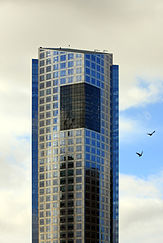 |
|
|
The Barolo tower, arguably Argentina's best-known Art Nouveau building and César Pelli's Repsol-YPF tower, a clear example of the postmodern style of buildings in Puerto Madero.
|
||
Buenos Aires architecture is characterized by its eclectic nature, with elements resembling Barcelona, Paris and Madrid. There is a mix, due to immigration, of Colonial, Art Deco, Art Nouveau, Neo-Gothic and French Bourbon styles. Italian and French influences increased after the declaration of independence at the beginning of the 19th century, though the academic style persisted until the first decades of the 20th century.
Attempts at renovation took place during the second half of the 19th century and the beginning of the 20th, when European influences penetrated into the country, reflected by several buildings of Buenos Aires such as the Iglesia Santa Felicitas by Ernesto Bunge; the Palace of Justice, the National Congress, and the Teatro Colón, all of them by Vittorio Meano.
The simplicity of the Rioplatense baroque style can be clearly seen in Buenos Aires through the works of Italian architects such as André Blanqui and Antonio Masella, in the churches of San Ignacio, Nuestra Señora del Pilar, the Cathedral and the Cabildo.
In 1912 the Basilica del Santisimo Sacramento was opened to the public. Totally built by the generous donation of Mrs. Mercedes Castellanos de Anchorena, Argentina's most prominent family, the church is an excellent example of French neo-classicism. With extremely high-grade decorations in its interior, the magnificent Mutin-Cavaillé coll organ (the biggest ever installed in an Argentine church with more than four-thousand tubes and four manuals) presided the nave. The altar is full of marble, and was the biggest ever built in South America at that time.
In 1919 the construction of Palacio Barolo began. This was South America's tallest building at the time, and was the first Argentine skyscraper built with concrete (1919–1923). The building was equipped with 9 elevators, plus a 20-metre high lobby hall with paintings in the ceiling and Latin phrases embossed in golden bronze letters. A 300,000-candela beacon was installed at the top (110 m), making the building visible even from Uruguay. In 2009 the Barolo Palace went under an exhausive restoration, and the beacon was made operational again.
In 1936 the Kavanagh building was inaugurated, with 120 metres height, 12 elevators (provided by Otis) and the world's first central air-conditioning system (provided by north-American company "Carrier"), is still an architectural landmark in Buenos Aires.
The architecture of the second half of the 20th century continued to reproduce French neoclassic models, such as the headquarters of the Banco de la Nación Argentina built by Alejandro Bustillo, and the Museo Hispanoamericano de Buenos Aires of Martín Noel. However, since the 1930s the influence of Le Corbusier and European rationalism consolidated in a group of young architects from the University of Tucumán, among whom Amancio Williams stands out. The construction of skyscrapers proliferated in Buenos Aires until the 1950s. Newer modern high-technology buildings by Argentine architects in the last years of the 20th century and the beginning of the 21st include the Le Parc Tower by Mario Álvarez, the Torre Fortabat by Sánchez Elía and the Repsol-YPF tower by César Pelli.
Education
Primary education
Primary education comprises the first two EGB cycles (grades 1–6). Because of the system that was in place until 1995 (seven years of primary school plus five or six of secondary school), primary schools used to offer grades 1–7. Although most schools have already converted to teach the 8th and 9th grades, others chose to eliminate 7th grade altogether, forcing the students to complete the third cycle in another institution. Nevertheless, most primary schools in the city still adhere to the traditional seven-year primary school. EGB was never put in practice in Buenos Aires.
Secondary education
Secondary education in Argentina is called Polimodal ("polymodal", that is, having multiple modes), since it allows the student to choose his/her orientation. Polimodal is not yet obligatory but its completion is a requirement to enter colleges across the nation. Polimodal is usually 3 years of schooling, although some schools have a fourth year. Before entering the first year of polimodal, students choose an orientation, among these five: Humanities and Social Sciences, Economics and Management of Organizations, Art and Design, Health and Sport and Biology and Natural Sciences.
Conversely to what happened on primary schools, most secondary schools in Argentina contained grades 8th and 9th, plus Polimodal (old secondary), but then started converting to accept 7th grade students as well, thus allowing them to keep the same classmates for the whole EGB III cycle.
In December 2006 the Chamber of Deputies of the Argentine Congress passed a new National Education Law restoring the old system of primary followed by secondary education, making secondary education obligatory and a right, and increasing the length of compulsory education to 13 years. The government vowed to put the law in effect gradually, starting in 2007.
University education
There are many public universities in Argentina, as well as a number of private universities. The University of Buenos Aires, one of the top learning institutions in South America, has produced five Nobel Prize winners and provides taxpayer-funded education for students from all around the globe. Buenos Aires is a major centre for psychoanalysis, particularly the Lacanian school. Buenos Aires is home to several private universities of different quality, such as: Buenos Aires Institute of Technology, CEMA University, Favaloro University, Pontifical Catholic University of Argentina, University of Belgrano, University of Palermo, University of Salvador, and Torcuato di Tella University.
Tourism
According to the World Travel & Tourism Council, tourism has been growing in the Argentine capital since 2002. In a survey by the travel and tourism publication Travel + Leisure Magazine in 2008, travellers voted Buenos Aires the second most desirable city to visit after Florence, Italy. In 2008, an estimated 2.5 million visitors visited the city.
Visitors have many options such as going to a tango show, an estancia in the Province of Buenos Aires, or enjoy the traditional asado. New tourist circuits have recently evolved, devoted to famous Argentines such as Carlos Gardel, Eva Perón or Jorge Luis Borges. Before 2011, due to the favourable exchange rate, its shopping centres such as Alto Palermo, Paseo Alcorta, Patio Bullrich, Abasto de Buenos Aires and Galerías Pacífico were frequently visited by tourists. The exchange rate today has hampered tourism and shopping in particular. Notable consumer brands such as Tiffany & Co. have abandoned the country due to the exchange rate and import restrictions.
The city also plays host to musical festivals, some of the largest of which are Quilmes Rock, Creamfields BA and the Buenos Aires Jazz Festival.
Notable streets
- Avenida Alvear passes through the upscale Recoleta area, and is the address for five-star hotels and embassies, many of them former mansions.
- Caminito, colorfully restored by local artist Benito Quinquela Martín
- Avenida Corrientes, a principal thoroughfare in Buenos Aires, and intimately tied to the Tango and Porteño culture
- Avenida del Libertador connects downtown to upscale areas in the northwest, passing by many of the city's best-known museums, gardens and cultural points of interest
- Avenida de Mayo is often compared with those of Madrid, Barcelona and Paris for its sophisticated buildings of Art Nouveau, Neoclassic and eclectic styles
- Florida Street, a downtown pedestrian street
- Avenida 9 de Julio, one of the widest avenues in the world; its name honours Argentina's Independence Day
Neighborhoods
- Belgrano ( tipa-lined residential streets, Tudor architecture and numerous museums)
- La Boca (the old port district still maintains its 19th-century ambience)
- Palermo (a trendy neighbourhood filled with restaurants, shops and clubs called boliches)
- Parque Patricios (technology district)
- Puerto Madero (these 1880-era docklands are now the city's newest neighbourhood with a modern skyline and upscale restaurants)
- Recoleta (the traditionally upscale district combines Parisian architecture with trendy highrises and a variety of cultural venues)
- Retiro (Art Nouveau cafés and restaurants among Art Deco office architecture)
- San Telmo (one of the oldest neighborhoods of Buenos Aires, this area is characterized by well-preserved 19th century architecture)
Parks
- Parque Tres de Febrero (this park, one of the city's largest, is home to a rose garden and paddleboat lake)
- Botanical Gardens (among the oldest in Latin America and an easy walk to other Palermo-area sights)
- Buenos Aires Japanese Gardens (the largest of its type in the World, outside Japan)
- Plaza de Mayo (surrounded by national and city government offices, this square has been central to many of Argentina's historical events)
- Plaza San Martín (central to the Retiro area, the leafy park is surrounded by architectural landmarks)
- Recoleta Cemetery (includes graves of many of Argentina's historical figures, including Eva Perón, several presidents and scientists, as well many among Argentina's influential families)
- Buenos Aires Zoo (renowned for its collection and the Hindu Revival elephant house)
Landmarks
- Cabildo (seat of government house during colonial times)
- Caminito (renowned for Benito Quinquela Martín's pastel hues and wall reliefs)
- Casa Rosada (the official seat of the executive branch of the Argentine government)
- Central Post Office (soon to be reopened as the Bicentennial Cultural Centre)
- City Legislature (the monumental neoclassical building also houses two libraries and a museum)
- Kavanagh building (the Art Deco residential building was the first true skyscraper in Buenos Aires)
- Metropolitan Cathedral (mother church of the Archdiocese of Buenos Aires)
- National Congress (Argentine Parliament)
- National Library (the largest library in Argentina and one of the most important in the Americas)
- National Museum of History (original documents, former presidents' belongings and recreated historical rooms)
- The Obelisk (one of the city's iconic landmarks and a venue for various cultural activities and other events)
- Teatro Colón (an internationally renowned opera house opened in 1908)
- The Water Company Palace (perhaps the world's most ornate water pumping station)
Shopping Centers
- Abasto de Buenos Aires
- Galerías Pacífico
- Patio Bullrich
- Alto Palermo
- Dot Baires Shopping
- Galería Güemes
Theatre
- Teatro Colón
- Cervantes Theatre
- Teatro Gran Rex
- Avenida Theatre
- Teatro General San Martín
Coffee Shop
- Café Tortoni
- Confitería El Molino
- Café 36 Billares
- Confitería London City
- Café Iberia
- Café Los Angelitos
- Café de García
- Café Las Violetas
- Café La Paz
- Café Las Violetas
Libraries and bookstores
Argentina has the highest readership in Latin America, surpassing the 74% of readers per year. Buenos Aires is the Latin American city with more libraries and reading centers.
Transport
Local roads and personal transport
Buenos Aires is based on a square, rectangular grid pattern, save for natural barriers or the relatively rare developments explicitly designed otherwise (notably, the neighbourhood of Parque Chas). The rectangular grid provides for square blocks named manzanas, with a length of roughly 110 meters. Pedestrian zones in the city centre, like Florida Street are partially car-free and always bustling, access provided by bus and the Metro (subte) Line C. Buenos Aires, for the most part, is a very walkable city and the majority of residents in Buenos Aires use public transport.
Two diagonal avenues in the city centre alleviate traffic and provide better access to Plaza de Mayo. Most avenues running into and out of the city centre are one-way and feature six or more lanes, with computer-controlled green waves to speed up traffic outside of peak times.
The city's principal avenues include the 140-metre (459 ft)-wide Avenida 9 de Julio, the over-35 km (22 mi)-long Avenida Rivadavia, and Avenida Corrientes, the main thoroughfare of culture and entertainment.
In the 1940s and 1950s the Avenida General Paz beltway that surrounds the city along its border with Buenos Aires Province and freeways leading to the new international airport and to the northern suburbs heralded a new era in Buenos Aires traffic. Encouraged by pro-automaker policies pursued towards the end of the Perón (1955) and Frondizi administrations (1958–62) in particular, auto sales nationally grew from an average of 30,000 during the 1920–57 era to around 250,000 in the 1970s and over 600,000 in 2008. Today, over 1.8 million vehicles (nearly one-fifth of Argentina's total) are registered in Buenos Aires.
Toll motorways opened in the late 1970s by then-mayor Osvaldo Cacciatore provided fast access to the city centre and are today used by over a million vehicles daily. Cacciatore likewise had financial district streets (roughly one square kilometre in area) closed to private cars during daytime. Most major avenues are, however, gridlocked at peak hours. Following the economic mini-boom of the 1990s, record numbers started commuting by car and congestion increased, as did the time-honored Argentine custom of taking weekends off in the countryside.
Cycling
In December 2010, the city government launched a bicycle sharing program with bicycles free for hire upon registration. Located in mostly central areas, there are 21 rental stations throughout the city providing over 700 bicycles to be picked up and dropped off at any station within an hour. The bike-share program runs from 8:00 am to 8:00 pm Monday through Friday and from 9:00 am to 3:00 pm on Saturdays. As of 2012, the city has constructed 70 km (43.50 mi) of protected bicycle lanes and has plans to construct another 100 km (62.14 mi).
Local public transport
-
Buenos Aires bus rapid transit
Commuter rail
The Buenos Aires commuter rail system has seven lines:
- Belgrano Norte Line
- Belgrano Sur Line
- Roca Line
- San Martín Line
- Sarmiento Line
- Mitre Line
- Urquiza Line
The Buenos Aires commuter network system is very extensive: every day more than 1.3 million people commute to the Argentine capital. These suburban trains operate between 4 am and 1 am. The Buenos Aires railway system also connects the city with long-distance rail to Rosario and Córdoba, among other metropolitan areas. There are four principal terminals for both long-distance and local passenger services in the city centre: Constitucion, Retiro, Federico Lacroze and Once.
Underground
The Buenos Aires Underground (locally known as subte, from "subterráneo" meaning underground or metro), is a high-yield system providing access to various parts of the city. Opened in 1913, it is the oldest underground system in the Southern Hemisphere and second oldest in the Spanish-speaking world after Madrid's in Spain. The system has six lines, named by letters (A to E, and H) There are 74 stations, and 52.3 km (32 mi) of route. An expansion program is underway to extend existing lines into the outer neighborhoods and add a new north-south line. Route length is expected to reach 89 km (55 mi) by 2011. Line "A" is the oldest one (service opened to public in 1913) and stations kept the "belle-époque" decoration, the trains still sport incandescent-bulb illumination and doors must be manually opened by the passengers, as in 1913. Daily ridership on weekdays is 1.7 million and on the increase. Fares remain relatively cheap, although the city government hiked the fares by over 125% in January 2012. A single journey, with unlimited interchanges between lines, now costs AR$2.50, which is roughly USD$0.60. The Buenos Aires Underground has six lines which also have links to the commuter rail.
Current renovation and expansion
The subway is currently undergoing renovation and expansion.
- At Line A two new stations after Carabobo are under construction, being Nazca the new future terminal while newer metro carriages are slowly being introduced to handle the increased demand.
- On Line B Since 2004, work began to expand the line to Villa Ortúzar and Villa Urquiza.
- On Line H further extensions are planned to run from Retiro to Nueva Pompeya once constructed. It will connect the Southern part of the city with the North, thus improving the flow to the centre of the city, and will be approximately 11 km (6.8 mi) long from end to end. The Line H will provide cross-connections with almost all the other lines.
- On Line E work has begun in 2009 to expand the line up to Retiro.
Planned underground lines
New underground lines are planned and were presented by the Government of the City of Buenos Aires on 26 May 2007. There are currently three lines planned:
- Line F would join Constitución Station with Plaza Italia and would have an extension of 7.6 km (4.7 mi). It would be transverse-radial, according to the section, with strong integration with the rest of the network.
- Line G would connect the Retiro Station with the Cid Campeador and would have a length of 7.6 km (4.7 mi). It would be radial to connect the axes of high-density residential and commercial areas, and would bring the underground to the northwest of the city.
- Line I would run from the Emilio Mitre (Line E) Station to Plaza Italia, a distance of 7.3 km (4.5 mi). It would be the outermost transverse line of the network and would link the neighborhoods of the north, centre and south of the city and link with the radial lines far from the city centre.
Tramways
Buenos Aires had an extensive street railway (tram) system with over 857 km (533 mi) of track, which was dismantled during the 1960s in favour of bus transportation, but surface rail transport has made a small comeback in some parts of the city. The PreMetro or Line E2 is a 7.4 km (4.6 mi) light rail line that connects with Metro Line E at Plaza de los Virreyes station and runs to General Savio and Centro Cívico. It is operated by Metrovías. The official inauguration took place on 27 August 1987.
A 2 km (1.2 mi) modern tramway, the Tranvía del Este, opened in 2007 in the Puerto Madero district, using two tramcars on temporary loan. However, plans to extend the line and acquire a fleet of trams did not come to fruition, and declining patronage led to the line's closure in October 2012. A heritage streetcar maintained by tram fans operates on weekends, near the Primera Junta line A metro station in the Caballito neighbourhood.
Buses
There are over 150 city bus lines called Colectivos, each one managed by an individual company. These compete with each other, and attract exceptionally high use with virtually no public financial support. Their frequency makes them equal to the underground systems of other cities, but buses cover a far wider area than the underground system. Colectivos in Buenos Aires do not have a fixed timetable, but run from four to several per hour, depending on the bus line and time of the day. With inexpensive tickets and extensive routes, usually no further than four blocks from commuters' residences, the colectivo is the most popular mode of transport around the city.
Buenos Aires has recently opened a two-lane 12 km (7.5 mi), bus rapid transit system, the MetroBus. The system uses modular median stations that serve both directions of travel, which enable pre-paid, multiple-door, level boarding. The system runs across the Juan B. Justo Ave has 21 stations and was inaugurated on 31 May 2011.
SUBE card
The SUBE card is a contactless smart card system introduced in February 2009 by Argentina's President. It is used on public transport services within the Buenos Aires metropolitan area and was promoted by the Argentine Secretary of Transportation. It is valid on a number of different travel systems across the city including Buenos Aires Metro, buses and trains. This change has helped speed passengers on to the bus. People no longer have to wait to be issued a printed receipt as they enter the bus. This should help reduce emissions of carbon dioxide and nitrogen because buses don't have to idle as long while passengers load, helping improve air quality in the city. The electronic ticket is eliminating the printed receipts, thus lowering the amount of littering in the city. The city, in turn, no longer has to process, collect, count, and transport coinage received in payment of some 11 million trips per day.
Taxis
A fleet of 40,000 black-and-yellow taxis ply the streets at all hours. License controls are not enforced rigorously. There have been numerous reports of organized crime controlling the access of taxis to the city airports and other major destinations. Taxi drivers are known for trying to take advantage of tourists. Radio-link companies provide reliable and safe service; many such companies provide incentives for frequent users. Low-fare limo services, known as remises, have become popular in recent years.
Intercity transport
High-speed rail
A new high-speed rail line between Buenos Aires, Rosario and Córdoba, with speeds up to 320 km/h is planned.
Long-distance bus terminal
The main terminal for long-distance buses is Retiro bus station, near Retiro railway station, from where buses depart for all parts of Argentina and for neighbouring countries.
Ferries
Buenos Aires is also served by a ferry system operated by the company Buquebus that connects the port of Buenos Aires with the main cities of Uruguay, ( Colonia del Sacramento, Montevideo and Punta del Este). More than 2.2 million people per year travel between Argentina and Uruguay with Buquebus. One of these ships is a catamaran, which can reach a top speed of about 80 km/h (50 mph), making it the fastest ferry in the world.
Airports
The Buenos Aires international airport, Ministro Pistarini International Airport, is located in the suburb of Ezeiza and is often called "Ezeiza". The Aeroparque Jorge Newbery airport, located in the Palermo district next to the riverbank, serves only domestic traffic and flights to Brazil, Chile, Paraguay and Uruguay. A smaller San Fernando Airport serves only general aviation.
Security
The Guardia Urbana de Buenos Aires (Buenos Aires Urban Guard) was a specialized civilian force of the city of Buenos Aires, Argentina, that used to deal with different urban conflicts with the objective of develop actions of prevention, dissuasion and mediation, promoting effective behaviors that guarantee the security and the integrity of public order and social coexistence. The unit continuously assisted the personnel of the Argentine Federal Police, especially in emergency situations, events of massive concurrence, and protection of tourist establishments.
The group permanently did controls of seat belt use, blood alcohol content tests, and traffic order; also its agents are enabled to offer quick and objective information to tourists and foreign people. Other functions include take part when a public case of intentional damage or negligence happen; anyway, its personnel always must act in a preventive, educative, dissuasive and coordinated form.
The Urban Guard officials did not carry any weapon in the performing of their duties. Their basic tools are an HT radio transmissor and a whistle.
As of March 2008, the Guardia Urbana was removed. Its people were "recycled" into a new law enforcement organization, about traffic order called the Seguridad Vial.
The Metropolitan Police is the police force under the authority of the Autonomous City (or Federal District) of Buenos Aires. The force was created in 2010 and is composed of 1,850 officers, and is planned to expand to 16,000. Security in the city is concurrently the responsibility of the Metropolitan Police and the Argentine Federal Police.
The city government claims the new force is based on the model of the British London Metropolitan Police and the New York Police Department. The force was intended to use high technology support and adopt a policy of zero tolerance.
The police are headed by a Chief and a Deputy Chief. Both are appointed by the head of the executive branch of the City.
There are four major departments, each headed by a Director General:
- Public Security
- Investigations and Research
- Scientific and Technical
- Administration
Geographically, the force is divided into 15 precincts.
Of the 1,850 officers, 900 are used for patrolling the streets.
Sports
Football is a passion for Argentines. Buenos Aires has the highest concentration of football teams of any city in the world (featuring no fewer than 24 professional football teams), with many of its teams playing in the major league. The best-known rivalry is the one between River Plate and Boca Juniors. Watching a match between these two teams was deemed one of the "50 sporting things you must do before you die" by The Observer. Other major clubs include San Lorenzo de Almagro, Club Atlético Huracán, Vélez Sársfield, Asociación Atlética Argentinos Juniors and Club Ferro Carril Oeste.
Diego Armando Maradona, born in Lanús Partido (county) south of Buenos Aires, is widely hailed as one of the greatest football players of all time. Maradona started his career with Argentinos Juniors, later playing for Boca Juniors, the Argentina national football team and others (most notably FC Barcelona in Spain and SSC Napoli in Italy).
Buenos Aires has been a candidate city for the Summer Olympic Games on three occasions: for the 1956 Games, which were lost by a single vote to Melbourne; for the 1968 Summer Olympics, held in Mexico City; and in 2004, when the games were awarded to Athens. However, Buenos Aires hosted the first Pan American Games (1951) and was also host city to several World Championship events: the 1950 and 1990 Basketball World Championships, the 1982 and 2002 Men's Volleyball World Championships and, most remembered, the 1978 FIFA World Cup, won by Argentina on 25 June 1978, when it defeated the Netherlands by 3–1. In September 2013, the city will host the 125th IOC Session, where the International Olympic Committee will select the host city of the 2020 Summer Olympics as well as a new IOC President. Buenos Aires is currently bidding to host the 2018 Summer Youth Olympics.
Juan Manuel Fangio won five Formula One World Driver's Championships, and was only outstripped by Michael Schumacher, with seven Championships. The Buenos Aires Oscar Gálvez car-racing track hosted 20 Formula One events as the Argentine Grand Prix, between 1953 and 1998; it was discontinued on financial grounds. The track features various local categories on most weekends.
The 2009 and 2010 Dakar Rally started and ended in the city.
Argentines' love for horses can be experienced in several ways: horse racing at the Hipódromo Argentino de Palermo racetrack, polo in the Campo Argentino de Polo (located just across Libertador Avenue from the Hipódromo), and pato, a kind of basketball played on horseback that was declared the national game in 1953.
Buenos Aires native Guillermo Vilas (who was raised in Mar del Plata) was one of the great tennis players of the 1970s and 1980s, and popularized tennis Nationwide in Argentina. He won the ATP Buenos Aires numerous times in the 1970s. Other popular sports in Buenos Aires are golf, basketball, rugby, field hockey and cricket.
Famous residents
- Pope Francis, current Pope (Mar. 13, 2013- ), known as the Archbishop of Buenos Aires, and then Cardinal Jorge Mario Bergoglio
International relations
World rankings
Buenos Aires is an important node in the global economic system.
The city is classified as an Alpha World City, according to the Loughborough University group's (GaWC) 2008 inventory.
It is ranked 22nd in the 2010 ranking of global cities by the American journal Foreign Policy, in conjunction with consulting firm A.T. Kearney and the Chicago Council on Global Affairs. (See " Global city" for the top 30 in the list.)
Twin towns and sister cities
Buenos Aires is twinned with the following cities:
|



